I was one of the few reviewers, it seems, that distinctly did not like Assassin’s Creed: Origins. I felt the Role-Playing Game gameplay elements weren’t great, the story was beyond awful, and the map was hideously oversized. Especially considering I hadn’t even visited seven of the map sectors before finishing the game. Well, Assassin’s Creed Odyssey is now here and while it somewhat fixes the gameplay and story, it turbo-charges the map issue. The map in Odyssey is so vast it becomes almost completely overwhelming. Honestly, this is just one of the many issues with the game.
Review: Assassin’s Creed Odyssey
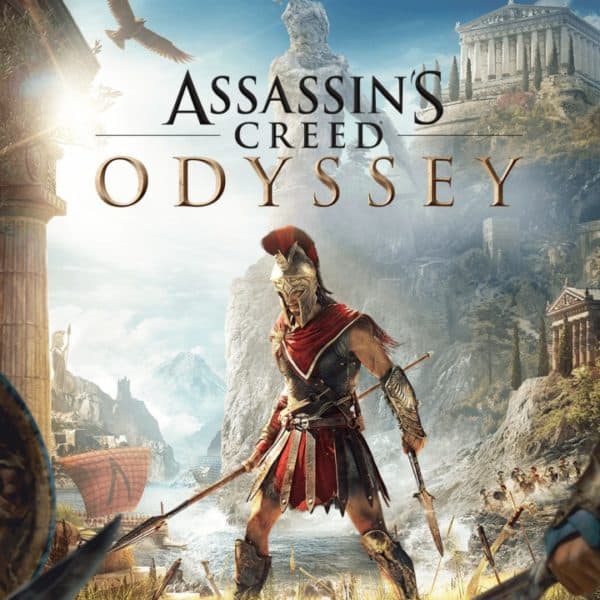
Title: Assassin’s Creed Odyssey
Platform: PlayStation 4 [Reviewed], Xbox One, PC
Genre: Third-Person Action Adventure
Developer: Ubisoft Quebec
Publisher: Ubisoft
Players: 1
Release Date: October 5th, 2018
Price: $59.99 (USD)
A Small Aside
To start off with, I probably scored Origins higher than what it deserved: I gave it a 7 out of 10. However, in hindsight, it probably should have been a 5. That said, while Odyssey is a better game, it has its own set of issues that seriously derail it. If Odyssey had been a 20-30 hour game, like most of the past Assassin’s Creed games, it would be perfectly fine. Instead, this is a minimum 70-hour game that is incredibly bloated and contains many odd elements. This detracts from the overall experience.
An Odyssey’s Start
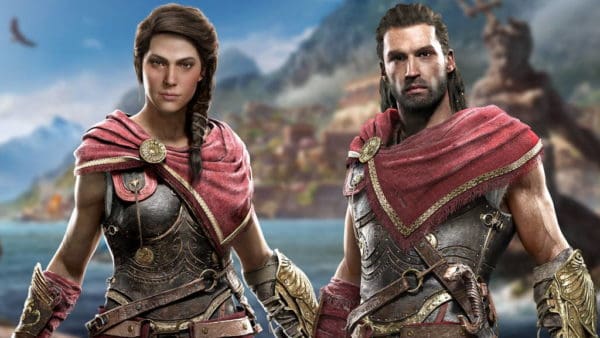
The opening of Odyssey is an interesting one. You now have the choice of playing either as male (Alexios) or female (Kassandra). Here’s a tip: play as Kassandra. While the story for each character is identical, she has the superior voice actor and a more interesting overall personality. You start off the game a few years older than your sibling (you’re around 4 or 5 years old, and the sibling is a baby) when the family is shattered by a decree from an oracle. The game then flash-forwards to the current time, when you are an adult.
Character
Kassandra isn’t quite as fleshed out as Bayek was in Origins or as maybe Ezio or Edward were in their respective games. Although, she is all about the benjamins, or Drachma, which in this case is a mercenary who works for whomever they want. Kassandra is also dealing with some family trauma, although not her overriding issue, at least at the moment anyway. It does become a somewhat bigger conflict later on in the story.
Nuts and Bolts Gameplay Changes
When looking at Origins and Odyssey side-by-side, they appear to be very similar. However, appearances are deceiving. Since there are key differences to the core gameplay that set Odyssey apart from its predecessor.
For one, your Overpower (super) attack becomes available much more frequently and also isn’t an all-or-nothing attack. In Origins, you built up adrenaline to fill a bar and unleashed your Overpower attack. This caused either a single-hit for massive damage, a sweep for clearing groups of enemies surrounding you, or a speed/attack buff dependent on specific weapons. You could only use the attack once the whole bar was full, and if you wasted it, it could take a while to rebuild.
In Odyssey, the bar has different segments and can be expanded as you level up your spear, (more on that later.) Initially, you can only do one Overpower attack, which requires three bars to use, but as your meter gets longer, you go from only having four bar slots to seven or eight. This means you can do multiple Overpower attacks in a fight. Making combat much easier than in Origins.
Nuts and Bolts Pt. 2
Another change is that you don’t have a shield. In Origins, defending attacks with your shield was key, even if it was a little silly. In Odyssey, you basically have a dodge move and a parry against regular attacks. If an attack is red, you can’t block it, but if the attack is white, you can. There also aren’t any smoke bombs in the game either.
Bows are vastly simplified in this game as well. In Origins, there were a few different bow classes: a sniper bow, a shotgun bow that you could shoot multiple arrows with at a time, and another might be average in all classes. In Odyssey, bow classes are mapped to your skill tree and you pick what you want. You can pick a skill that marks four enemy targets and lets you shoot arrows at them all at the same time, or you can pick the ability that lets you guide arrows through the air in slo-mo like The Matrix. This is another good change for simplifying the game.
Abilities
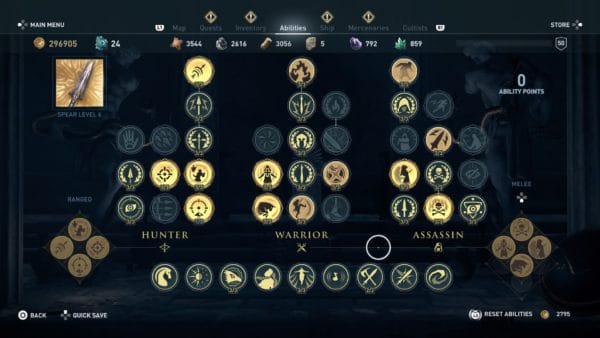
Alongside the simplification of the Overpower attack, you now have more active (and passive) skills to utilize in combat. The active ones require adrenaline to use, but it’s only one bar, as opposed to three. Some active ones are like the Spartan Kick ability, a Bull Rush move or, most broken of all, a Rush Assassination move that basically gives you a Warp Strike à la Final Fantasy XV. You chuck your spear at them and can either instantly kill or severely damage any enemy, as long as you are in stealth. You can then chain that attack into another one (hurling your spear at a nearby enemy) to repeat the process. This move can be done up to four times once fully upgraded, and it’s one of the more ludicrous, yet still fun things in the game.
Upgrades
There are the usual three skill trees that all RPG-esque action games have: hunter (bows), warrior (melee), and, assassin (stealth, utility). You will not have enough points to max out all abilities so you have to pick and choose what you want to unlock. You can reset your points, but it requires some cash to do so.
Outfits vs. Gear

One thing that isn’t simplified is the overall gear system. In Origins, you could purchase outfits or unlock them for completing quests, but they were cosmetic. In a practical sense, they served as merely a different skin for Bayek and didn’t do anything for your gameplay experience. This is totally different for Kassandra in Odyssey. You wear and equip gear in five different slots: head, gloves, chest, belt, and boots. Each can confer different bonuses for your character and contribute to your armor value.
Odyssey still keeps the traditional RPG rarity system (blue, purple, yellow) for gear quality, so finding a yellow helm is almost always going to be better than getting a blue, or even color-less (basic) helm. Because there is actual gear, it somewhat balances out level progression. Your effectiveness isn’t tied intrinsically to your weapon level and overall character level, so you can change your character’s focus at any time. The downside is that it can be a hassle keeping up with all the different armor you find.
Grinding it Out
So what do you do with your old and dis-used gear? Well, you can either sell it to a vendor for Drachma, or you can dismantle it for core resources. There are six resources to deal with: wood, leather, metal, ancient tablets, obsidian glass, and precious gems. The first four are used for upgrading both your ship and your gear/weapons.
For your gear, let’s say you have a sword you really like that is level 18, but you are level 25. At that point, the sword is probably not as effective as it once was, so you can spend Drachma as well as resources (usually metal, wood, and leather) to upgrade it to your current level. This raises the DPS of the sword to be more effective.
For your ship, you’ll usually be using wood, metal, and tablets (for some reason). There are different systems you can upgrade on your ship, like your ramming ability or your hull strength. These also tie into the color system, so your max-level archers will be colored yellow.
Engraving
So, what do you do with the other two resources I listed, glass and gems? Well, you can use those to put engravings on your gear. As you collect more and more gear, you’ll unlock new engravings to tie to your weapons. Engravings grant you bonus effects that, while still passive in nature, are typically more specialized. For example, increasing your Spartan Kick move, or decreasing by one bar the amount of adrenaline required to use an Overpower move (which is useful), or letting all your attacks deal poison damage.
You earn engravings by leveling up, killing certain cult members or other named characters, and by finding epic gear. If a piece of epic gear has some unique effect on it like Unlimited Air for Underwater Swimming, it’s added to your Engraving pool and can then be added to most items. Some engravings are slot-specific, like certain weapons or chest piece engravings, but for the most part, you can customize however you want. Sadly, you can’t double-stack bonuses. For instance, you can’t add +10% Warrior Damage and +10% Warrior Damage for a total 20% Warrior Damage, but it’s nonetheless a versatile system.
Naval Combat
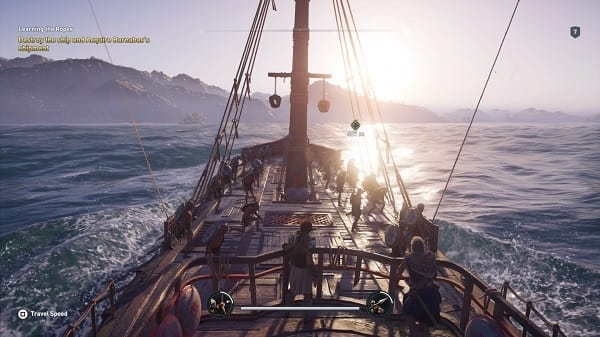
So, Ubisoft brought naval combat back for this game and I’m kind of questioning why. For one, it is almost the exact same system as in Assassin’s Creed IV or Assassin’s Creed Rogue. Only now, you have two distinct ranged attacks, arrows and javelins, and each has a cool down. You can also deal fire damage, once you buy the upgrade, which is basically an adrenaline system for the boat. Once a ship is sufficiently damaged, you can board it to take out its crew. Your ship also gains some health back and you’ll get some experience/resources from it, which is fine but not needed.
However, the naval combat in the game is entirely perfunctory. It is simply there. There are a few, very specific story missions or quests where you actually have to do ship combat but it barely exists in the overall experience of the game. It’s no better than in AC4, and in some cases, it’s a tad worse. And while it’s not “bad,” it just seems like a waste of time.
Naval Crew Gathering
A new and slightly weird system in Odyssey is how you gain new crew members for your ship. You don’t gain new lieutenants by saving them from guards or as part of a story, but only by recruiting almost any type of enemy in the game. Depending on their particular skill, lieutenants bestow bonuses such as increased fire damage or ship health.
Just as with gear, enemies are color-coded based on how good they are. You can see this from the sky via your eagle vision with literally an eagle. You can then attempt to deliver an unarmed strike against a target, which functions like a non-lethal takedown. If the strike is successful, you can then recruit the enemy to your side. If it is not successful, you’ll have to whittle their health down and then you can try a non-lethal attack to get them into a recruitment-ready state.
Like I said, this is a weird system. You almost always have to fight someone to be able to recruit them. Also, you only have one move in your arsenal that actually can make someone be recruitable. You can put new crewmates into one of four slots on your ship (once upgraded). They really are only good for the bonuses they afford you. Although there is an ability to use them as combat allies on land, it’s not particularly useful. This whole system struck me as a bastardization of the recruitment mechanics from Metal Gear Solid: Peace Walker, only not as well thought out.
The Odysseys Come
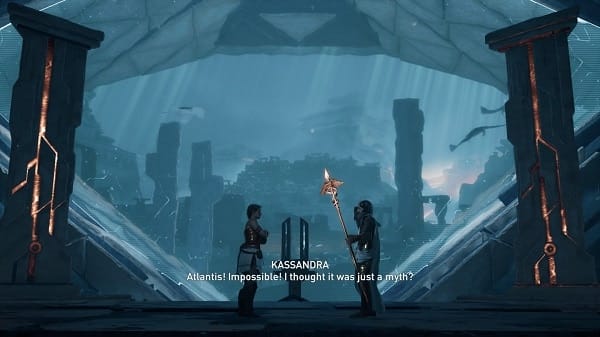
There are three somewhat intertwined storylines in AC Odyssey to keep you busy. They are as follows (with minimal spoilers).
- The Family Affair – You are tasked with trying to repair your broken family. This includes finding your mother, father, and sibling who was thought to have been lost but actually survived
- The Cult of Kosmos – Wouldn’t you know it, there’s another nefarious cult you have to take down? Its secret members have their grubby hands in much of Greek life.
- The Atlantis Affair – You are told you need to gather three artifacts to close down Atlantis, (an Isu knowledge site.) This involves you hunting various mythological creatures in the game.
These different stories intertwine somewhat but aren’t entirely dependent on one another. You can take them at your own pace. If you instead want to complete the family storyline as quickly as possible, you are free to do so. The Cult and Atlantis ones are somewhat story-driven, certain cult members only show up during certain missions, but you can also take most of them out as well.
Red vs. Blue
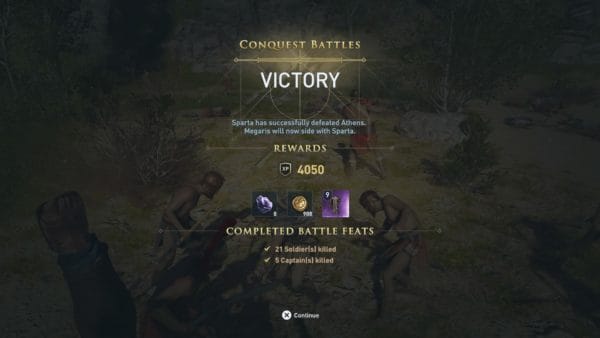
The most strange system in the game is some quasi-territory control thing that makes no sense. Any given region either has Athens or Spartan soldiers defending it. You can weaken their control by assaulting bases, stealing money, killing guards, burning supplies, etc., to the point where they become vulnerable. You can then initiate a battle, either attacking the region for the other team or defending it (from your own destabilization) for the current team.
In the press releases for the game, they showed those massive on-foot battles where you are fighting off dozens of enemies; this is that conquest battle thing. There is little reason to do any of this stuff, outside of getting some gear or experience points. There’s no meta-game of “Well, Athens controls all of Greece, here are the bonuses and perks you get.” At a certain point in the Family Odyssey, you basically become a Spartan again, so I have no idea if after that point, why you’d be doing any more Athenian work.
There is no upside to any side of the war actually controlling any district or island. You don’t get more rewards if there is a majority imbalance on one side or another. You get no money, faction-specific abilities, or bonuses. It is an entirely hollow system. At least back in 2004, when playing Grand Theft Auto: San Andreas, when you took over a part of Los Santos, it was for your own gang. You would get more money based on how much of the city you had, much as in Saints Row 3. In this game, you get nothing and that makes it all entirely pointless.
Mercenaries
Another somewhat baffling new system involves the Mercenaries. The previous game had the Phylakes, bounty hunters who targeted you if you committed too many crimes in public. These specialized and powerful enemies would hunt you down until you paid them off, or simply murdered them. The Mercenary system in Odyssey is somewhat similar but has a few essential changes.
For one, Kassandra has her own Mercenary ranking. So, the more higher-ranked Mercs you kill, the more your own ranking improves. Also, it’s easier to just pay to get rid of them, if you don’t want to be bothered, via the in-game map.
A Not So Nemesis System
The most jarring change is that Ubisoft tried (and failed) to implement some quasi-Nemesis system for the Mercenaries. One Merc might use fire attacks and take less ranged damage. While another might use an animal in battle and take more poison damage. Mercenaries seem somewhat randomly generated as you go on, much like how random Orcs pop up in Shadow of Mordor.
The difference is that the Orcs in Mordor had a personality and there was some element of persistence. If you died from an Orc in Mordor, it would level up and gain more fame for killing you. Conversely, if you defeated an Orc and didn’t kill him, it would try to hunt you down later on for revenge and might have a new trick or two up its sleeve.
There is no element of persistence in Odyssey. If you die from a Mercenary attack, you just load up your last save game and continue on. Going up the Mercenary ranks unlocks passive bonuses for you, such as decreasing the cost of gear upgrades, or increasing the payouts of bounty quests. However, that doesn’t tangibly mean anything. I finished as Mercenary rank 1, the top dog, and if I murder someone randomly, a Mercenary is still dispatched to try and fight me. Why do this? I’m already at number 1. That should prove I can take out any random Merc with ease.
Level Up?

The biggest problem this game has is how it handles the quest/level system. All quests give a recommended level, and the side-quests and random quests are level appropriate. For example, if you have a quest to kill a certain Spartan captain, and your level is 38 (the level cap is 50), it’s almost certain that the recommendation will be between level 36 and 40. However, this is NOT the case with story quests, and in some cases, the game outright lies to you.
I had a quest to Upgrade your Spear, which endows you with notable bonuses. This is tied directly into the Cult Odyssey. You gain artifact shards to upgrade your spear and need a certain amount to gain a new level. The last “Upgrade Your Spear” quest I got was at level 24, and the quest was 25. In essence, the quest was telling me to kill every other member of the cult, some of which are level 50.
The Inherent Contradiction
How exactly am I, a level 24 Kassandra, supposed to take out a level 50 Cultist? Easy, I’m not! One hit from the cultist can kill Kassandra instantly. Dealing no damage to the cultist, because I’m too low-level. The game recommends I should do this quest though, despite knowing I can’t. These level glitches occurred with the Cult story, the Atlantis story, and the Arena quest line. It would routinely say “Oh, you match the recommended level for this quest,” but in actuality, the sub-quests or even core enemies of that quest would be vastly stronger than me.
The Atlantis storyline is a good example: the first part is a simple riddle so it doesn’t count, but the other three parts involve you fighting a Minotaur, Cyclops, and Medusa. Despite the game saying “Oh, you can do this, no biggie,” the Medusa is a level 50 elite enemy with oodles of nasty attacks. You have to be level 47, minimum, in order to be able to take it on with any success. There is a severe disconnect happening here.
Map Bloat
Leveling is by far the biggest crime that Odyssey commits. Although, its second biggest issue, the bloated world map is just as bad. Much like with Origins, the map is WAY too big for its own good. Prior to Odyssey’s release, I looked at the map image that Ubisoft put out and I wept inside because of its enormity. Most of it is littered with the same cookie-cutter sidequests Origins had.
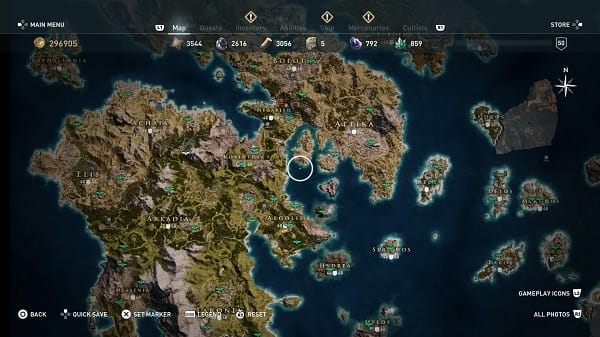
I hope you like killing Alpha animals because you’ll find endless caves and animal lairs full of them. The same goes for popping open the occasional chest, killing random captains or a Polemarch, freeing prisoners and so on. The old AC games had the problem of too many treasure chests/icons on the map (Assassin’s Creed Unity was famous for this) that made them seem oppressive. Well, this game (and Origins) have the same issue, only now instead of merely treasure chests on a map, there are hundreds of question marks, and each involves completing the same six or seven busy work tasks. One might argue this is more engaging than the simple chests of prior AC games, but at least those didn’t take up as much time.
The Present Day
It is fascinating how much Ubisoft has de-emphasized the Present Day narrative in the recent Assassin’s Creed games. You still play as Layla Hassan, introduced in Origins. She seems like an interesting character, somewhat not on the side of Assassins or Templars and trying to forge her own path. At least, that’s the theory.
You play as her thrice in Odyssey: one time is for exposition, one is for meaningless filler, and the last time has some light puzzle solving an 8-year-old could complete. You spend, all told, about nine minutes with her in total. I think Desmond got more screen time in the first Assassin’s Creed game than Layla does in this one. Why does this keep happening?
Why is Ubisoft SO reluctant to commit to any present-day stuff? To her credit, at least Layla has a character/personality, unlike the “Noob” and “Numbskull” characters you play as in AC4 and AC Rogue (I’m not kidding, that’s game canon), but you have no relationship with Layla. People still reflect fondly on the Desmond sequences from the earlier games because he was a well-written character that seemed believable. Layla could fit this mold also, but she’s barely in either game enough to matter at all.
The Cult of Kosmos

I’ll briefly touch on it here but as stated above, there’s another evil cult in the game. Thankfully Odyssey doesn’t make its WHOLE story about it, which is a plus. Typically, you have to find a clue as to the cultist’s real identity, then you can hunt them down and ice them.
I think there are too many cultists to hunt down and some overly obscure hints to even get a clue, but generally, it’s fine. I kept having flashbacks to the Web of Intrigue from Prototype and Prototype 2. Hopefully, Kassandra hates computers just as much as James Heller does.
Minor Annoyances
Here’s a small list of miscellaneous things that irked me about the game. Not enough to really bring down the overall experience, but annoying issues.
- As with Origins, it can be difficult to actually pick out your objective marker on a map. Having a golden yellow objective marker against a mostly sandy brown map isn’t very readable.
- Leveling can take a rather long time, particularly, later on.
- There are some optional tombs, but they are almost all brain-dead easy. There are no puzzles to really work out; you just have to be careful of snakes
- The romance element is incredibly silly. Ubisoft touted it as being almost akin to something like Mass Effect 2. If anything, the romance options in Saints Row 4 of “Hey, want to have sex?” Are more complex than the options in this game.
- There are multiple endings but it’s fairly obvious what triggers them. Basically, you can choose to kill or save certain characters. If they wanted a more strict moral system, they should have jacked it from Mass Effect 2.
Bugs
Yes, once again, an Assassin’s Creed game isn’t up to technical snuff. I’ve fallen through the world once or twice, had animals spawn inside rocks (making them unhittable), quests occasionally broke, the tutorial seemed to re-appear AFTER I completed the game, and so on.
Also, I went into a cave to kill two animals, one normal and one Alpha. After killing the normal one, the Alpha disappeared around a corner and into a wall. I managed to do a heavy attack and hit it, which then caused the wolf to fall through the game world and disappear entirely. Bug testing is still fun for these games.
Here’s an illustrative video:
Pros
- Has a much-improved story over Origins with some actual stakes
- Combat is better and isn’t quite as broken
- The gear system means you actually feel like you are enhancing your character’s skills, and not just your appearance
Cons
- The conquest/territory control system doesn’t amount to anything
- There are severe leveling issues with the game, meaning you have to be at almost max level to complete two of the stories
- Naval combat is boring.
- The Mercenary system has no personality
- Romance system is beyond simplistic
Final Thoughts
Overall Score: 7 out of 10. Assassin’s Creed is slowly getting better but still isn’t there yet. This latest entry throws a lot of new systems into play, building upon Origins, but most of them don’t yet seem fully-formed. It’s a decidedly better game than Origins, but it still seems that Assassin’s Creed has lost its identity and I’m not sure they actually have a plan for the franchise. Maybe by taking a year off in 2019, they can figure that out.
This game was reviewed using a retail copy purchased by W2Mnet.com
